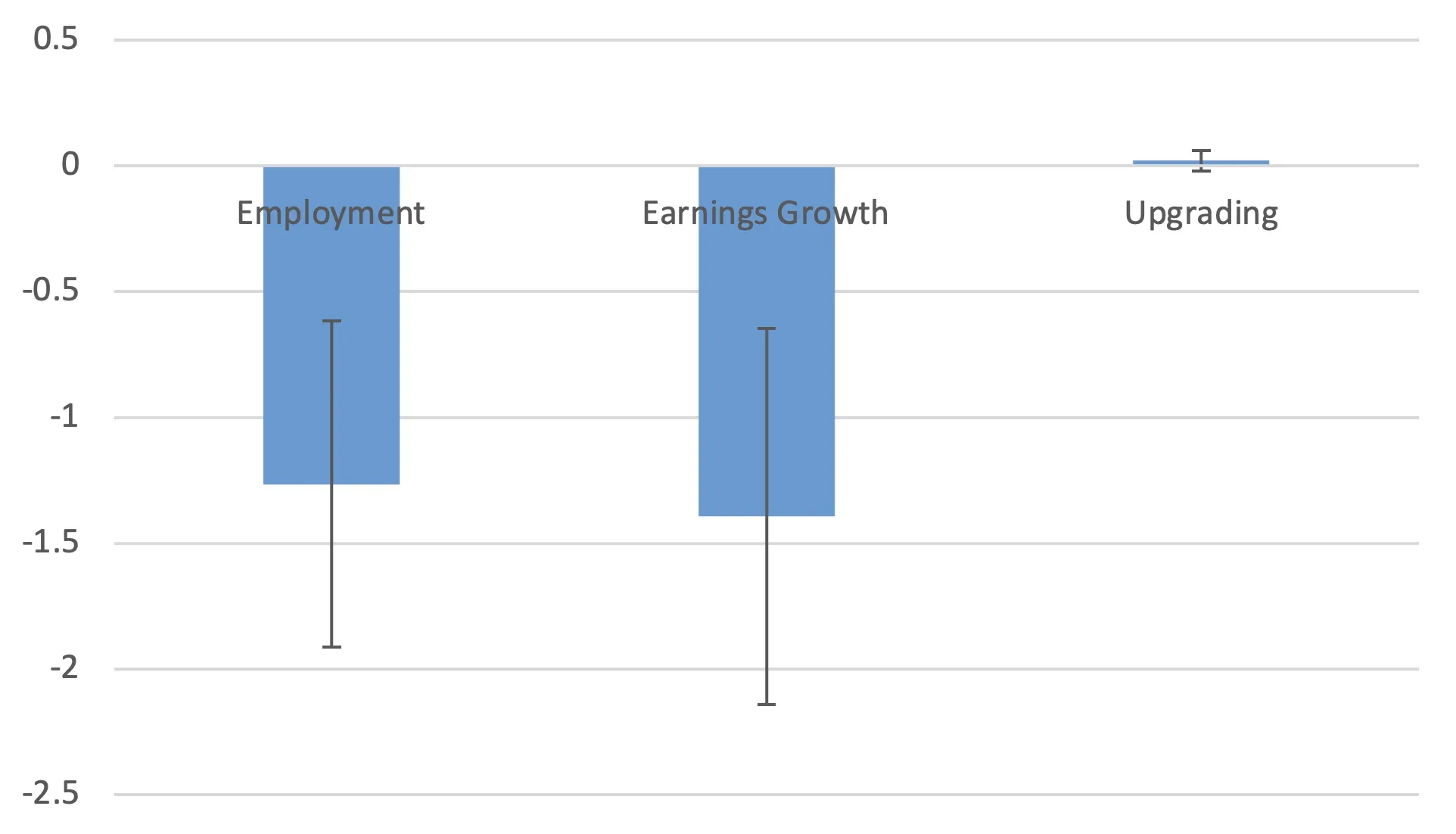
The Effect of New Technologies on Workers, Jobs, and Skills
- The adoption of technological and organizational change (T&O) in German firms is associated with a decline in routine jobs.
- However, individuals in routine roles are not more likely to move into non-employment following T&O, nor do they experience diminished earnings growth. Instead, they are significantly more likely to move to higher-skilled non-routine positions in the same company or elsewhere.
- One exception was found: workers over the age of 55 exposed to T&O adoption are more likely to face permanent unemployment without significant opportunities to transition to higher-skilled non-routine positions.
- Firms that offer apprenticeship training and unionized firms are more likely to enhance the skills of their employees when introducing T&O measures.
Source Publication:
Michele Battisti, Christian Dustmann, and Uta Schönberg, Technological and Organizational Change and the Careers of Workers, Journal of the European Economic Association, Volume 21, Issue 4, August 2023, Pages 1551–1594. This paper is also featured on VoxEU
Technological and organizational change (T&O) is widely regarded as a key driver behind the decreasing employment share of routine jobs, which typically involve repetitive and prescribed tasks. However, the disappearance of routine jobs does not automatically mean workers in these roles will exit employment and suffer earnings losses—although this scenario often dominates the popular public debate. Even if their current positions are eliminated due to T&O, they may transition to other roles that align with and complement the changes brought about by T&O, either within the same company or at different organizations. Michele Battisti, Christian Dustmann, and Uta Schönberg (2023) (BDS hereafter) provide an in-depth investigation of how firms and workers adapt to T&O in the context of Germany.
Their study combines firm- and worker-level data spanning two decades, from 1993 to 2013. They match a representative survey of up to 16,000 firms in Germany that provides detailed information on organizational change, innovation, and training activities with the work histories of all employees who have ever worked at any of the firms included in the survey. The study then tracks firm and worker outcomes in firms that adopt technological and organizational changes at different points in time before and after the adoption of such changes.
The authors’ research demonstrates the adoption of T&O leads to a reduction in routine jobs within firms. Companies implementing T&O decrease their proportion of routine employment relative to non-adopting firms, even within the same industry and local labor market. Despite this decrease in routine jobs, workers in routine positions are not more likely to become unemployed or experience a decline in earnings growth following T&O implementation. Instead, they are notably more inclined to transition to higher-skilled non-routine roles within the same organization or elsewhere (refer to Panel A of Figure 1). Therefore, although T&O does result in the elimination of some routine jobs, the workers in these positions do not necessarily face negative outcomes.
However, BDS finds an exception for workers over age 55, because T&O is linked to a permanent loss of employment for this demographic group (refer to Panel B of Figure 1). Older workers in routine jobs have minimal opportunities to transition to non-routine positions, likely due to the challenges associated with retraining and with acquiring new skills in response to T&O.
Investigating differences across firms, BDS finds skill upgrading following T&O is more prevalent in firms that run apprenticeship training schemes, possibly because these firms already possess expertise in delivering in-house training. Additionally, BDS documents a higher frequency of worker upskilling in response to T&O in companies that are part of employer associations and thus adhere to union wage agreements. One possible explanation is that unions actively participate in providing training opportunities for workers, which can ultimately benefit the companies.
Figure 1: Effects of T&O on Individual Labor Market Outcomes

Panel A: All Routine Workers

Panel B: Routine Workers Aged 55-59
Notes: The figure displays coefficient estimates and 95% confidence intervals for the impact of T&O implemented in the firm over a three-year period (between t-3 and t) on worker outcomes in period t. In Panel A, the sample refers to workers who were employed in routine positions in the firm in period t-3. In Panel B, the sample is further restricted to routine workers who were between 55 and 59 years old in t-3 (Panel B). T&O is measured as the number of organizational changes the firm has implemented between t-3 and t and ranges from 0 to 4 (the sum of four indicator variables for whether the firm has shifted responsibilities and delegated decisions, whether it has introduced teamwork or working groups with their own responsibilities, whether it has introduced profit centers [i.e., units or departments that carry out their own cost and result calculations], and whether it has internally restructured or merged departments or areas of activities).
Data Source: IAB Establishment Panel matched with worker histories.
Consistent with the idea that technological advancements tend to favor routine tasks, BDS research demonstrates companies adopting T&O decrease the proportion of their employees in routine roles. Yet, in contrast to the conventional belief largely influenced by studies in the US, the findings from BDS indicate that, at least in Germany and excluding older employees, individuals previously in routine positions do not typically experience employment losses or decreased earnings growth following the implementation of T&O. Instead, they tend to transition into more skilled roles.
An important implication of this research is that the shift in skill demands brought about by technological advancements does not necessarily lead to substantial welfare losses, even for workers whose roles are eliminated and whose existing skills become somewhat outdated. BDS’s findings further suggest Germany’s labor market institutions—specifically its apprenticeship system and unions’ involvement in training activities—may help lessen T&O’s potentially harmful effects on worker careers.







